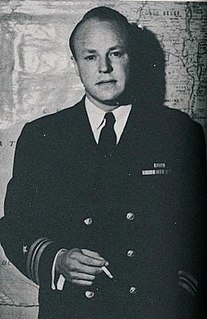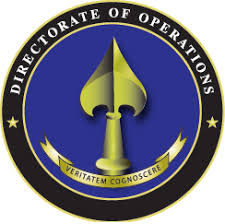
The National Reconnaissance Office (NRO) is a member of the United States Intelligence Community and an agency of the United States Department of Defense which designs, builds, launches, and operates the reconnaissance satellites of the U.S. federal government, and provides satellite intelligence to several government agencies, particularly signals intelligence (SIGINT) to the NSA, imagery intelligence (IMINT) to the NGA, and measurement and signature intelligence (MASINT) to the DIA.

The Director of Central Intelligence (DCI) was the head of the American Central Intelligence Agency from 1946 to 2005, acting as the principal intelligence advisor to the President of the United States and the United States National Security Council, as well as the coordinator of intelligence activities among and between the various US intelligence agencies.

The United States Intelligence Community (IC) is a group of separate United States government intelligence agencies and subordinate organizations that work both separately and collectively to conduct intelligence activities which support the foreign policy and national security of the United States. Member organizations of the IC include intelligence agencies, military intelligence, and civilian intelligence and analysis offices within federal executive departments.

William Harding Jackson was a U.S. civilian administrator, New York lawyer, and investment banker who served as Deputy Director of the Central Intelligence Agency. Jackson also served briefly under President Dwight D. Eisenhower as Acting United States National Security Advisor from 1956 to 1957.

The Robertson Panel was a scientific committee which met in January 1953 headed by Howard P. Robertson. The Panel arose from a recommendation to the Intelligence Advisory Committee (IAC) in December 1952 from a Central Intelligence Agency (CIA) review of the U.S. Air Force investigation into unidentified flying objects, Project Blue Book. The CIA review itself was in response to widespread reports of unidentified flying objects, especially in the Washington, D.C. area during the summer of 1952.

Frank Gardiner Wisner was one of the founding officers of the Central Intelligence Agency (CIA) and played a major role in CIA operations throughout the 1950s.

The Directorate of Operations (DO), less formally called the Clandestine Service, is a component of the US Central Intelligence Agency. It was known as the Directorate of Plans from 1951 to 1973; as the Directorate of Operations from 1973 to 2005; and as the National Clandestine Service (NCS) from 2005 to 2015.

Ferdinand A. Eberstadt was an American lawyer, investment banker, and an important policy advisor to the United States government who was instrumental in the creation of the National Security Council and the Central Intelligence Agency.
The National Intelligence Board (NIB), formerly the National Foreign Intelligence Board and before that the United States Intelligence Board is a body of senior U.S. Intelligence Community leaders currently led by the Director of National Intelligence (DNI). The Board is tasked with reviewing and approving National Intelligence Estimates (NIEs).
The Israeli Intelligence Community is made up of Aman, Mossad and Shabak.
The counter-terrorism page primarily deals with special police or military organizations that carry out arrest or direct combat with terrorists. This page deals with the other aspects of counter-terrorism:
The Dulles–Jackson–Correa Report was one of the most influential evaluations of the functioning of the United States Intelligence Community, and in particular, the Central Intelligence Agency (CIA). The report focused primarily on the coordination and organization of the CIA and offered suggestions that refined the US intelligence effort in the early stages of the Cold War.
United States Intelligence Community Oversight duties are shared by both the executive and legislative branches of the government. Oversight, in this case, is the supervision of intelligence agencies, and making them accountable for their actions. Generally oversight bodies look at the following general issues: following policymaker needs, the quality of analysis, operations, and legality of actions.
The Schlesinger Report, originally titled A Review of the Intelligence Community, was the product of a survey authorized by U.S. President Richard Nixon late in 1970. The objective of the survey was to identify and alleviate factors of ineffectiveness within the United States Intelligence Community (IC) organization, planning, and preparedness for future growth. The report, prepared by James Schlesinger, Deputy Director of the Office of Management and Budget (OMB), was submitted to Nixon on 10 March 1971.
At various times since the creation of the Central Intelligence Agency, the Federal government of the United States has produced comprehensive reports on CIA actions that marked historical watersheds in how CIA went about trying to fulfill its vague charter purposes from 1947. These reports were the result of internal or presidential studies, external investigations by congressional committees or other arms of the Federal government of the United States, or even the simple releases and declassification of large quantities of documents by the CIA.

The CIA publishes organizational charts of its agency. Here are a few examples.
The Boren-McCurdy intelligence reform proposals were two legislative proposals from Senator David Boren and Representative Dave McCurdy in 1992. Both pieces of legislation proposed the creation of a National Intelligence Director. Neither bill passed into law.
The Report on the Covert Activities of the Central Intelligence Agency is a 69-page formerly classified comprehensive study on the personnel, security, adequacy, and efficacy of the Central Intelligence Agency written by Lieutenant General James H. Doolittle. United States President Dwight Eisenhower requested the report in July 1954 at the height of the Cold War and following coups in Iran and Guatemala. The report compares with other contemporary Cold War documents such as George Kennan's "X" article in Foreign Affairs, which recommended a policy of "containment" rather than direct confrontation with the Soviet Union, and NSC 68, the secret policy document produced in 1950, which recommended a similarly restrained policy of “gradual coercion.” Doolittle wrote with an abandon-all-principles approach that conveyed the national fear that the United States faced the prospect of annihilation at the hands of the Soviet Union: “It is now clear that we are facing an implacable enemy whose avowed objective is world domination by whatever means and at whatever cost,” Doolittle wrote. “There are no rules in such a game… If the United States is to survive, long standing concepts of ‘fair play’ must be reconsidered.” Doolittle’s forceful policy and language reflected the fear that motivated American citizens and policymakers in the wake of Soviet Communism.
Intelligence Community Directive 301 is a rescinded United States Intelligence Community Directive issued in 2006 to push emphasis on making open source intelligence the source of first resort among the intelligence community. The 9/11 terrorist attacks drove this directive forward as there was a call for many intelligence disciplines to work collectively on assessing and predicting threats to the United States. Intelligence Community Directive 301 outlined responsibilities and established policies on the intelligence community regarding open source intelligence activities. It was rescinded in 2012.

The National Open Source-Intelligence Agency (NOSA) is a proposed 19th member of the United States Intelligence Community (IC) to be tasked with the collection and exploitation of open source intelligence (OSINT). Creation of the agency would consolidate open source efforts across the US government into a new functional manager for the open source intelligence discipline, drawing resources from the Open Source Enterprise of the Central Intelligence Agency, the Open Source Integration Center of the Defense Intelligence Agency, the National Geospatial-Intelligence Agency, as well as other open source focused entities across the government.








